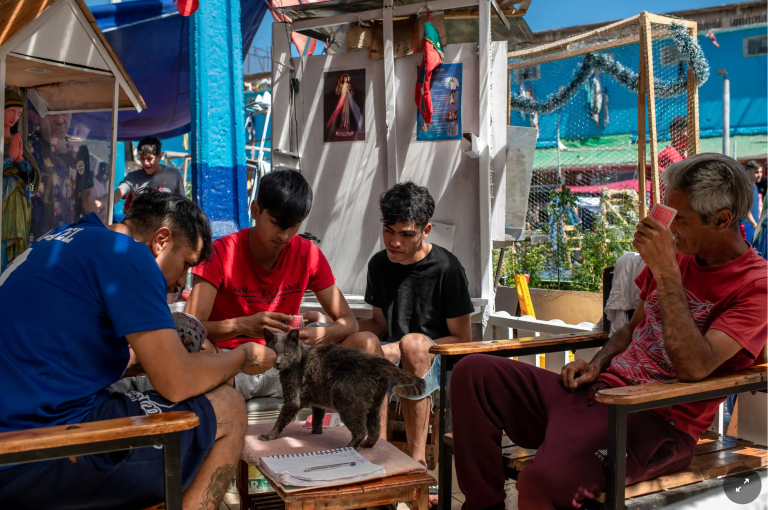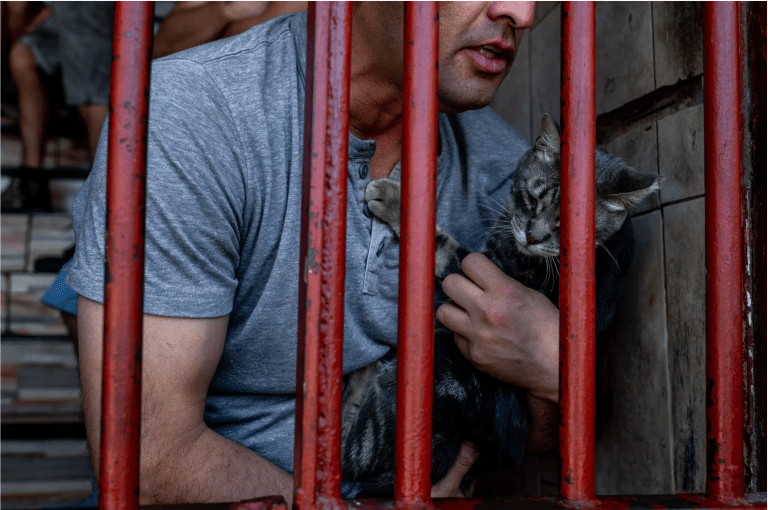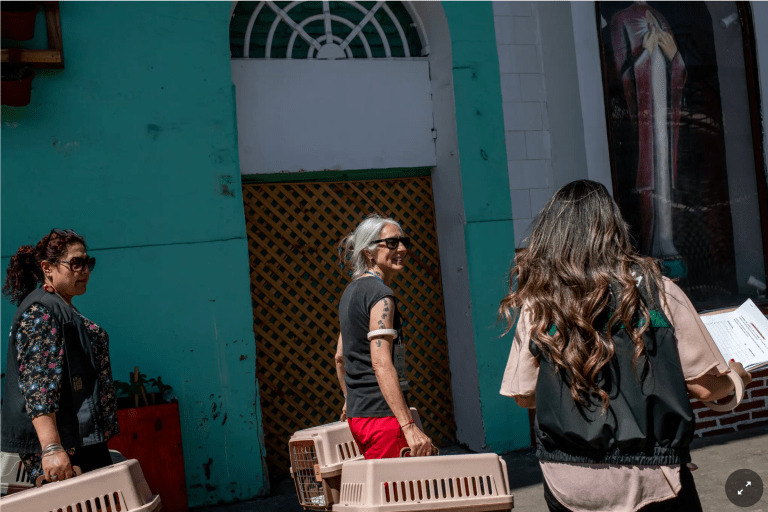From the NYT, we hear about how feral cats invaded a Chilean prison and then (as one expects) the prisoners became ailurophiles. Click below to read, or find it archived here.
Excerpts:
Some say they were first brought in to take out the rats. Others contend they wandered in on their own.
What everyone can agree on — including those who have lived or worked at Chile’s largest prison the longest — is that the cats were here first.
For decades, they have walked along the prison’s high walls, sunbathed on the metal roof and skittered between cells crowded with 10 men each. To prison officials, they were a peculiarity of sorts, and mostly ignored. The cats kept multiplying into the hundreds.
Then prison officials realized something else: The feline residents were not only good for the rat problem. They were also good for the inmates.
“They’re our companions,” said Carlos Nuñez, a balding prisoner showing off a 2-year-old tabby he named Feita, or Ugly, from behind prison bars. While caring for multiple cats during his 14-year sentence for home burglary, he said he discovered their special essence, compared with, say, a cellmate or even a dog.
YES! “Even a d*g”!!!!

“A cat makes you worry about it, feed it, take care of it, give it special attention,” he said. “When we were outside and free, we never did this. We discovered it in here.”
Known simply as “the Pen,” the 180-year-old main penitentiary in Santiago, Chile’s capital, has long been known as a place where men live in cages and cats roam free. What is now more clearly understood is the positive effect of the prison’s roughly 300 cats on the 5,600 human residents.
The felines’ presence “has changed the inmates’ mood, has regulated their behavior and has strengthened their sense of responsibility with their duties, especially caring for animals,” said the prison’s warden, Col. Helen Leal González, who has two cats of her own at home, Reina and Dante, and a collection of cat figurines on her desk.
“Prisons are hostile places,” she added in her office, wearing a tight bun, billy club and combat boots. “So of course, when you see there’s an animal giving affection and generating these positive feelings, it logically causes a change in behavior, a change in mindset.”
Prisoners informally adopt the cats, work together to care for them, share their food and beds and, in some cases, have built them little houses. In return, the cats provide something invaluable in a lockup notorious for overcrowding and squalid conditions: love, affection and acceptance.
“Sometimes you’ll be depressed and it’s like she senses that you’re a bit down,” said Reinaldo Rodriguez, 48, who is scheduled to be imprisoned until 2031 on a firearms conviction. “She comes and glues herself to you. She’ll touch her face to yours.

Formal programs to connect prisoners and animals became more common in the late 1970s, and after consistently positive results, they have expanded across the world, including to Japan, the Netherlands and Brazil.
They have become particularly popular in the United States. In Arizona, prisoners train wild horses to patrol the U.S. border with Mexico. In Minnesota and Michigan, prisoners train dogs for the blind and deaf. And in Massachusetts, prisoners help care for wounded or sick wildlife, like hawks, coyotes and raccoons.
Connecting inmates and dogs has repeatedly been shown to lead to “a decrease in recidivism, improved empathy, improved social skills and a safer and more positive relationship between inmates and prison officials,” said Beatriz Villafaina-Domínguez, a researcher in Spain who reviewed 20 separate studies of such programs.
Dogs have been the most common animal used by prisons, followed by horses, and in most programs, animals are brought to the inmates, or vice versa. In Chile, however, the inmates developed an organic connection to the stray cats who live alongside them.
Chileans know best!
The program’s success has been partly thanks to the inmates, Ms. Sandoval said. The prisoners collect cats that need care and bring them to the volunteers.
On a recent day, four women lugged cat carriers into the prison grounds, on the hunt for a number of felines, including Lucky, Aquila, Dropón and her six new kittens, and Mr. Nuñez’s cat, Ugly.
The courtyard was chaotic, packed for an inmate soccer match, but prisoners politely made way for the women.
Quickly, men cradling cats in tattooed arms came bounding down stairs along the courtyard, handing animals through prison bars to the volunteers. In one stop, Denys Carmona Rojas, 57, a prisoner serving eight years on gun charges, doted on a litter of kittens in a box. He said he had helped raise many kittens in his cell, recounting one case in which he fed special milk to a litter after the mother died during birth.
******************
From CNN, a short tail of a Thai farmer who plants rice at different times in a field so that the growing shoots, which change color, create the image of a sleeping cat hugging a fish. Click to read:
A sleeping cat hugs a fish in a picture seen from the air, picked out in sprouting rainbow seedlings in a rice field in Thailand to illustrate a traditional proverb about abundance.
Farmer Tanyapong Jaikham and a team of workers planted the seedlings at various spots in the field in the northern province of Chiang Rai to depict cartoon cats, hoping to lure tourists and cat lovers.
“We’re expecting tens of thousands to come and see the art in the rice fields,” he said.
The process relies on GPS coordinates to position the seedlings as designated in an initial artist’s sketch, he said, with the plants changing tint as they grow.
R“It’s crucial to position them accurately, and the rice will gradually change shades over time,” he added, until in the final harvest stage, the rice straw yields the portrait of Cooper, the cat on which it was modeled.Viewing towers are being built in the surrounding area to give visitors a glimpse of the artwork, which is based on a Thai saying, “There is fish in the water and rice in the fields.”
*****************
And here’s a 9.5-minute video of the Way Things Should be: cats cooperating to defeat predatory d*gs (TRIGGER WARNING: Scratching and biting of d*gs! What I don’t understand why the photographer, in the second clip, didn’t help the blind man and his guide dog. People would prefer to film violence than stop it. Fortunately, it looks as if no dogs were hurt.
Notice the cats’ bushy tails.
*****************
Lagniappe: A heartwarming video of a disheveled and sick stray kitten saved and turned into a lovely housecat.
h/t: Susan, Debra





Ha! We will be visiting Chang Rai for the first time this November. Will look for this.
Plenty of Cat Culture in Chiang Mai, where we stay often.
This week on Sam Harris’s podcast, Sam had an interesting conversation with John Gray, a British philosopher. I was so interested in the conversation that I looked up the guy’s books and found– Feline Philosophy: Cats and the Meaning of Life. I bought the Kindle version this morning.
It’s evidently about how human philosophy is an attempt tp escape anxiety that cats, by nature, don’t share, and find happiness such as cats arrive at naturally when not under threat. I’m sure there’s more to it than that summary, but I’ve only read the first few pages so far. I thought PCC(E) might be interested (it if hasn’t already been mentioned here on some previous Caturday).
Awesome stuff! Love the story of the prison cats as well as the high-tech rice field.
Perhaps the most interesting of all is the YouTube of cats attaching d*gs. I don’t think I’ve ever seen cats gang up on another animal before, but I have seen individual cats attack, but seemingly only in fear, never with such unbridled aggression. I wonder if the examples in the video are best interpreted as cats misunderstanding or mis-identifying the social cues. Dog and cat societies are very different and, it seems to me, that there are may opportunities for misunderstanding when the two species find themselves together.
Sitting in our garden one sunny afternoon we saw our male cat being chased by an Alsatian in the next garden. The cat leapt the fence, and, as the dog stuck his nose through, the cat turned and struck at it. After a few repetitions of this, our small and delicate (!!) female ran over, swiped the male away, and took her own turn at the dog. He ran away.
Thanks for another fascinating Trifecta. Yes, it’s rather disturbing that someone filmed the distressed blind guy and his d*g without trying to assist them.
The rice field is very impressive!
Have never before seen in real life or a video of coordinated cats attacking. Had one experience, with an unknown cat who startied coming towards me in my own yard, clearly looking for a fight, and I immediately backed into my house without taking my eyes off of him.
Worked in a vets office for many years, and once a visiting doctor decide to ignore our warnings about an aggressive cat, and thought he was fast enough to scruff the cat in the cage and take him out for neutering.
Doctor had also had a martini lunch and wasn’t quite as fast as he thought he was. Cat shredded his arm in a matter of seconds, doc ended up in the hospital for three days.